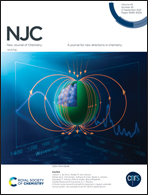Pyran based bipodal D–π–A systems: colorimetric and ratiometric sensing of mercury – experimental and theoretical approach†
Abstract
Two pyran based bipodal D–π–A systems, CAPBA and CAPTBA, have been developed as Hg2+ ion selective colorimetric and fluorescent ratiometric probes. Both probes formed a 1 : 2 complex, with two mercury ions per probe. The stoichiometry of binding, limit of detection and binding constants were determined using absorption and fluorescence spectroscopy. The metal ion complexation proceeds with deprotonation of the NH protons of the barbituric acid or thiobarbituric acid moiety which was characterized using 1H NMR spectroscopy and MALDI-TOF mass spectrometry. Fluorescence lifetime studies ascertained the formation of a static complex. DFT computations at the B3LYP and CAM-B3LYP levels of theory corroborated the experimental findings and further supported the deprotonation process during complex formation. The complexation is found to be reversible on treatment with cysteamine hydrochloride.



 Please wait while we load your content...
Please wait while we load your content...